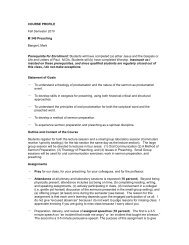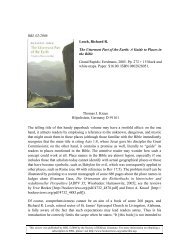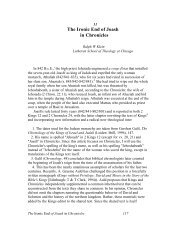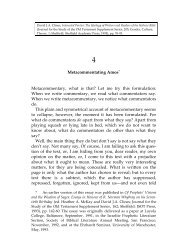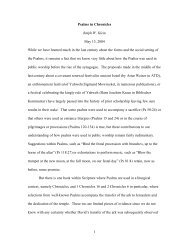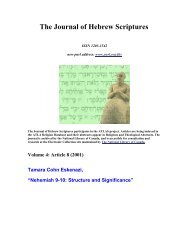Download this PDF file - University of Alberta - Journal Hosting
Download this PDF file - University of Alberta - Journal Hosting
Download this PDF file - University of Alberta - Journal Hosting
Create successful ePaper yourself
Turn your PDF publications into a flip-book with our unique Google optimized e-Paper software.
“IN CONVERSATION WITH ODED LIPSCHITS” 47border zones (the Negev, the southern Shephelah, the southern part <strong>of</strong>the Judean hills and the Jordan valley). I also have tried to connect thearchaeological situation in the area around Jerusalem to the Babylonianinterdiction against its restoration, like Hadrian’s in a much later periodand for similar reasons.One may also compare the wider picture <strong>of</strong> regional differencesbetween the former Assyrian provinces in the territory <strong>of</strong> the formerIsraelite kingdom. There is a clear continuation in the material cultureand no sign for a change in the demographic or geopolitical situationbetween the seventh and the fifth centuries BCE, and the destiny <strong>of</strong> theconquered Babylonian small kingdoms where a destruction and changecan be noticed mainly in the urban centers and in the peripheral areas.This is also a subject with great importance for understanding <strong>of</strong> thehistory <strong>of</strong> the region not only during the Babylonian period, but alsoduring the Persian and up to the Hasmonean period, when thingschanged again in a very drastic and dramatic way. All in all, I can'taccept the ideas <strong>of</strong> destruction without a plan, or <strong>of</strong> ruling without apolicy. In <strong>this</strong> respect, Pr<strong>of</strong>. Albertz made a very importantdifferentiation between the policy <strong>of</strong> Nabopolasar and Nebuchadrezzarand between the ideology behind their policies. There is much more todiscuss on <strong>this</strong> subject.The similarities between the Babylonian policy in Ammon and inJudah can't be ignored. 41 It was a different policy from that <strong>of</strong> theAssyrians, but not so different from the policy <strong>of</strong> the Persians. TheBabylonians conquered vast territories that were organized by theAssyrians as provinces whose inhabitants had lost their national andcultural identity. Only in the periphery there remained kingdoms withdistinctive national characteristics. These kingdoms were relativelysmall, with well-defined political and religious centers where the eliteresided. Consequently, the Babylonians were able to establish their ruleover those centers or alternately to destroy them, and to deport only (ormainly) the elite <strong>of</strong> such kingdoms. In doing so, they left in place largesectors <strong>of</strong> the population, particularly the rural sector, without makingany effort to rehabilitate the economy and administration. 42 TheAchaemenid rule continued with the same policy towards the provincesin the hill country. 43 The weak urban society in the hill country was aresult <strong>of</strong> the Assyrian and Babylonian destructions and deportations, aswell as the outcome <strong>of</strong> the agricultural economy, so characteristic to <strong>this</strong>region. 44 We can assume that just like the Babylonians, the41 Lipschits, “Ammon in Transition from Vassal kingdom to BabylonianProvince,” op.cit., no te 4.42 Vanderho<strong>of</strong>t, op.cit., note 6.43 Lipschits, “Achaemenid Imperial Policy, Settlement Processes inPalestine, and the Status <strong>of</strong> Jerusalem in the Middle <strong>of</strong> the Fifth Century BCE.”op.ci t ., note 4.44 See Briant, P., From Cyrus to Alexander: A History <strong>of</strong> the Persian Empire(Transl. Peter T. Daniels. Winona Lake, Ind.: Eisenbrauns, 2002; Englishtranslation <strong>of</strong> 1996 Histoire de l’empire perse de Cyrus à Alexandre: Volumes I-II.Achaemenid History 10. Leiden) 976. The distribution <strong>of</strong> Greek pottery, assummarized by Lehman, is one more example <strong>of</strong> the differences between theurban and commercial economy along the coast and the agricultural economy




